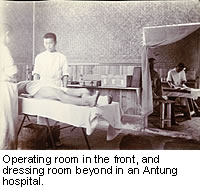American Angels of Mercy: Dr. Anita Newcomb McGee's Pictorial Record of the Russo-Japanese War, 1904
Hospital Ships
Japanese hospital ships were vital for their dual role of transporting and treating injured soldiers. Over twenty ships, each with a carrying capacity of 200 or more wounded, plied the ocean between Southern Manchuria and Japan. Two of these ships, the Kosai Maru and the Hakuai Maru, belonged to the Red Cross Society of Japan; the others were registered to the Japanese government.
The ships were fully outfitted as floating hospitals. Innovations such as X-ray machines, the latest aseptic surgical and disinfecting equipment, along with a bacteriological laboratory and a pharmacy, ensured that doctors and nurses had all they needed to treat patients. The medical complement of the Kobe Maru was typical of hospital ships, consisting of four doctors, two pharmacists, two clerks, a manager, and forty-four nurses (of whom three-quarters were women). In deeper water ports such as Dalny, wounded soldiers could be transferred directly onto hospital ships; casualties received from towns such as Antung, on the shallow Yalu River, had first to be moved great distances in small, flat-bottomed boats (lighters) and then loaded on board ship.
Hospital ships lived up to their names, such as charity (kosai) and benevolence (hakuai) and were also truly neutral, in keeping with the spirit and goal of the Red Cross. Convalescing Japanese and Russian troops who previously were deadly enemies, now strolled the decks sharing cigarettes and exchanging professional military courtesies. Ships' captains hosted delightful dinner parties at which Japanese and Russian officers and American and Japanese nurses observed the niceties of polite culture--perhaps ignoring, for the moment at least, that a war still raged.




